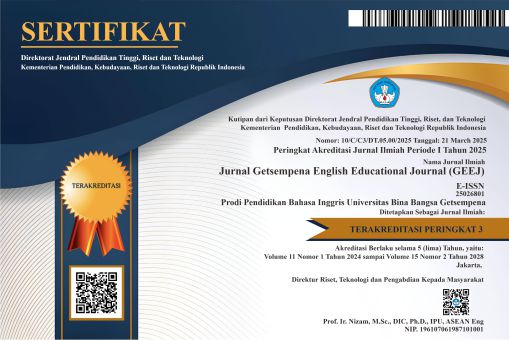AN ERROR ANALYSIS OF STUDENTS’ GRAMMAR IN WRITING
(A Mix Method at Darul Ulum, A Private Islamic Boarding Senior High School in Lhokseumawe)
Abstract
The aim of the research is to find out the grammar errors which are commonly made by the students of Darul Ulum Islamic Boarding Senior High School in their writing and to find out the causes of grammar errors which are commonly made by the students of Darul Ulum Islamic Boarding Senior High School in their writing. This research uses a qualitative and quantitative approach and its type is a mix study. The population is the total object of the research. In this research, the population was all the students of the first year students of MAS Darul Ulum in academic year 2015/2016, they are 120 students and divided into 56 male students and 64 female students. Result of the research from test most of the first year students of MAS Darul Ulum Lhokseumawe made many errors in grammatical aspects in writing, a high percentage of errors was found in one out of three categories. The highest error category was tense errors. They occurred 88 errors, while article is 19 time of errors and sentence 10 of errors. Total of all errors found in these three categories are 117 errors occurring in whole categories. Moreover, the students felt difficult in getting ideas to begin free writing. The causes of errors were made by the students because of lack of interactive facilities is one of the problems to develop interactive classroom activities. The errors made by students were influenced by their mother tongue, and were also caused by the difficulties of the students in learning the second language.
References
Bright, J.A., & Mc Gregor, G.P. (1970). TESL: Theory and Technique for the Secondary Stage. London: Longman.
Brooks, J.G (1960). In Search of Understanding: The Case for Constructivist Classroom. Alexandria, VA: Association for Supervision and Curriculum Development.
Brown, H. D. (1982). Principles of Language Learning and Teaching. New York: Longman.
Chandler. J. (2003). The Efficacy of Various Kinds of Error Feedback for Improvement in the Accuracy and Fluency of Students Writing. Journal of Second Language Writing, 12 (3) Retrieved September 15, 2013 from http://www.tesl-ej.org/wordpress/
Chomsky et. al. (1965) Rules and Representation. Blackwell: Oxford University Press.
Cook, V. (1994). Universal Grammar and the Learning and Teaching of Second Languages. In T. Odlin (Ed.), Perspectives on Pedagogical Grammar, Cambridge: Cambridge University Press.
Corder, S. P. (1981). Error Analysis and Interlanguage. Oxford: Oxford University Press.
_____________ (1982). Introduction Applied Linguistics. Middlesex: Penguin.
Ellis, R. (1997). Understanding Second Language Acquisition. Oxford: Oxford University Press.
Flower, L (1985). Problem Solving Strategies for Writing. London: Publisher Mellon University.
Gustian, M.S. (2012). “Error Analysis on the Use of Simple Past Tense among the Second Year Students of SMP Inshafuddin Banda Aceh (A Descriptive Study at the Second Year Students of SMP Insyafuddin Banda Aceh)”. Thesis. Banda Aceh: FKIP Bahasa Inggris Universitas Syiah Kuala.
Heaton, JB, (1988). Writing English Language Test, Revised Edition, London: Longman.
Hubbard, P. et al. (1983). A Training Course for TEFL. Oxford: Oxford University Press.
Lazaraton, A. (2001). Teaching English as a Second or Foreign Language, New York: Thomson Learning Inc.
Littlewood, W. T. (1984). Foreign and Second Language Learning: Language Acquisition Research and its Implications for the classroom. Cambridge: Cambridge University Press.
Made. (2000). An Introduction to Foreign Language Learning and Teaching. London: Pearson Education Limited.
Martin, H. M. (2003). Oxford Learner’s Pocket Dictionary. New York : Oxford University Press.
Nunan. D, (2005), Practical English Language: Grammar, International Edition, New York: The McGraw-Hill Companies, Inc.
________ (1995). Language Teaching Methodology: A Text Book for Teacher. Trenton: Prentice Hall.
Norrish, J. (1983). Language Learners and Their Errors. London: Macmillan.
Ponterotto, A. G (1986). Teaching English as a Second or Foreign Language. (2nd Ed). Boston: Heinle and Heinle.
Pounlston, B. (1976). Teaching English as Second Language and Procedure, New York : Little Brown and Company.
Richard, J. C. (1973). Error Analysis: Perspectives on Second Language Acquisition (2nd Ed). London: Longman.
Richard, N. (2012). “writing”, http://grammar.about. com/od/tz/g/writingterm.htm, access on 21 April 2014.
Rodney, H. (2000). Introduction to the Grammar of English, Cambridge: Cambridge University Press.
Rodney, H. Geoffrey, P. (2002). The Cambridge Grammar of the English Language, Cambridge: Cambridge University Press.
Scheter, P., & Celce Murcia, M. (1983) Communicative Competence: A Pedagogically Motivated Model with Content Specifications. Los Angeles: University of California Press.
Simor, A. writing definition, (online), 2012, http://www.omniglot.com/writing/definition/htm, accessed on 20 April 2014.
Sudjana. A. (2004), Pengantar Statistik Pendidikan. Jakarta: Grafindo Persada.
Sugiono. (2008). Memahami Penelitian Kualitatif. Bandung: ALFABETA.
Tarigan, H. G. (1989) Pengajaran Pragmatik: Bandung: Penerbit Angkasa.
Thornbury, S. (1999). How to Teach Grammar. London: Pearson Education.

























